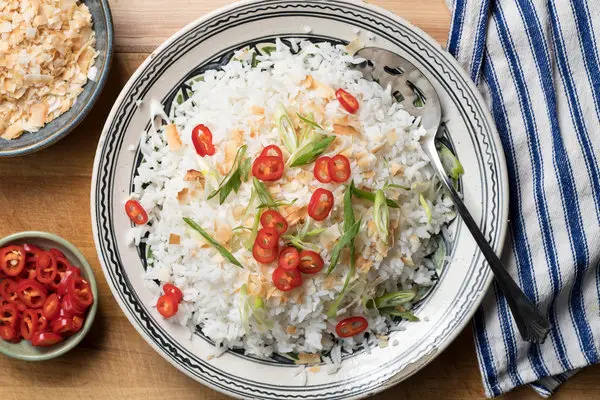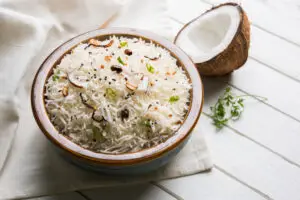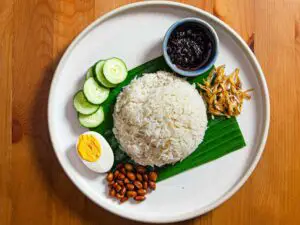Coconut rice is a delicious and aromatic rice dish that is prepared by cooking rice with coconut milk, giving it a rich and creamy flavor. It is a popular dish in many cuisines, particularly in Southeast Asian countries such as Thailand, Malaysia, and Indonesia.
To make coconut rice, long-grain rice is typically used, although other varieties like jasmine rice or basmati rice can also be used. The rice is cooked in a combination of coconut milk and water, which infuses it with a subtle coconut flavor and a creamy texture. Sometimes, additional ingredients like salt, spices, or grated coconut are added to enhance the taste.
Coconut rice is often served as a side dish to accompany various main courses such as curries, grilled meats or seafood, and stir-fries. The creamy and slightly sweet nature of the rice complements the bold and spicy flavors of these dishes, creating a harmonious balance on the palate.
The preparation of coconut rice may vary slightly depending on the specific cuisine or recipe being followed. However, the basic concept remains the same, with the focus on achieving a fluffy and fragrant rice dish that highlights the essence of coconut.
About Coconut rice
Welcome to our comprehensive guide on preparing the perfect coconut rice! If you’re a fan of flavorful and aromatic rice dishes, then this recipe is a must-try. In this article, we will walk you through the step-by-step process of creating mouthwatering coconut rice that will leave your taste buds craving more. Let’s dive in and discover the secrets to achieving culinary excellence with coconut rice.
Ingredients
- 2 cups of long-grain rice
- 1 can (13.5 oz) of coconut milk
- 1 cup of water
- 1 tablespoon of vegetable oil
- 1 teaspoon of salt
- 2 teaspoons of grated coconut (optional)
- Fresh cilantro or parsley for garnish
Preparation
Step 1: Washing the Rice
Before we start cooking, it’s crucial to wash the rice thoroughly to remove any excess starch. Place the rice in a bowl and rinse it under cold water, gently stirring it with your fingers. Repeat this process until the water runs clear, ensuring clean and fluffy rice.
Step 2: Cooking the Rice
In a large saucepan, heat the vegetable oil over medium heat. Add the washed rice and sauté it for a couple of minutes until it becomes slightly translucent. This process will help the rice grains remain separate after cooking.
Next, pour in the coconut milk and water, stirring gently to combine. Bring the mixture to a boil, then reduce the heat to low, cover the pan, and let it simmer for about 15-20 minutes or until the rice is tender and has absorbed the liquid.
Step 3: Fluffing the Rice
Once the rice is cooked, remove the saucepan from the heat and let it sit, covered, for an additional 5 minutes. This resting period allows the rice to absorb any remaining moisture fully. Afterward, use a fork to fluff the rice gently, separating the grains and enhancing the texture.
Step 4: Adding the Finishing Touches
To elevate the flavors, sprinkle the grated coconut over the cooked rice and give it a gentle stir. The grated coconut adds a delightful tropical twist to the dish, complementing the rich creaminess of the coconut milk.
Garnish your coconut rice with fresh cilantro or parsley, adding a touch of vibrant color and herbal freshness. These simple yet flavorful additions will enhance the overall presentation and taste of the dish.
Serving Suggestions
- Curries: Serve coconut rice alongside aromatic curries such as Thai red curry, Indian butter chicken, or Malaysian rendang for a harmonious blend of flavors.
- Grilled Seafood: The subtle sweetness of coconut rice complements the smoky flavors of grilled shrimp, fish, or scallops exceptionally well. Create a tropical seafood feast by combining these elements.
- Vegetable Stir-Fry: Add a healthy touch to your meal by pairing coconut rice with vibrant vegetable stir-fries. The creaminess of the rice perfectly balances the crispness of the vegetables.
Tips for Perfect Coconut Rice
- Rice Varieties: While long-grain rice is commonly used for coconut rice, you can experiment with other varieties such as jasmine rice or basmati rice to add different aromatic notes to the dish.
- Coconut Milk: Opt for high-quality coconut milk to ensure a rich and creamy texture. If you prefer a lighter coconut flavor, you can dilute the coconut milk with water, adjusting the ratio according to your taste preferences.
- Toasted Coconut: For an extra burst of flavor, toast the grated coconut in a dry pan until it turns golden brown. Sprinkle the toasted coconut over the cooked rice before serving to add a delightful crunch.
- Seasonings: While the recipe provided includes salt, feel free to experiment with other seasonings to enhance the flavor profile of your coconut rice. For a hint of spice, add a dash of cayenne pepper or a pinch of turmeric for a vibrant yellow color.
- Storage: If you have leftovers, store them in an airtight container in the refrigerator. Coconut rice can be reheated in the microwave or on the stovetop with a little water to restore its fluffy texture.
The Benefits of Coconut Rice
- Rich in Nutrients: Coconut milk is a good source of essential minerals such as manganese, copper, and iron. It also contains healthy fats that contribute to overall well-being.
- Energy Boost: As a carbohydrate-rich dish, coconut rice provides a sustainable source of energy, making it an excellent choice for athletes and those with active lifestyles.
- Digestive Health: The medium-chain triglycerides (MCTs) present in coconut milk can promote healthy digestion and support gut health.
- Gluten-Free Option: Coconut rice is naturally gluten-free, making it a safe and delicious choice for individuals with gluten sensitivities or celiac disease.
FAQs
Q: Can I use any type of rice for coconut rice?
A: While long-grain rice is the most commonly used variety for coconut rice, you can experiment with other types such as jasmine rice or basmati rice. Just keep in mind that the cooking times may vary slightly.
Q: Is coconut rice suitable for vegetarians and vegans?
A: Yes, it is suitable for both vegetarians and vegans. It is a plant-based dish that doesn’t contain any animal products.
Q: Can I make coconut rice without coconut milk?
A: Coconut milk is the key ingredient that gives coconut rice its distinct flavor and creamy texture. However, if you have dietary restrictions or preferences, you can try using alternatives such as almond milk or cashew milk, although the taste may differ slightly.
Q: How do I store leftover coconut rice?
A: To store leftover coconut rice, place it in an airtight container and refrigerate it. It can be kept in the refrigerator for up to 3-4 days. When reheating, add a little water or coconut milk to restore its moisture and fluffiness.
Q: Can coconut rice be frozen?
A: Yes, coconut rice can be frozen. Ensure that it is cooled completely before transferring it to freezer-safe containers or freezer bags. When ready to use, thaw it in the refrigerator overnight and reheat as needed.
Q: Can I adjust the level of spiciness in coconut rice?
A: Absolutely! If you prefer a spicier version, you can add finely chopped chili peppers, red pepper flakes, or a sprinkle of cayenne pepper to the rice while it’s cooking. Adjust the amount according to your desired level of heat.
Q: Is coconut rice a sweet dish?
A: Coconut rice is a savory dish with a subtle sweetness from the coconut milk. It is not typically prepared as a sweet dessert, although variations exist in some cuisines where sugar or sweetened coconut flakes are added.
Q: Can I use fresh coconut instead of canned coconut milk?
A: Yes, if you have access to fresh coconuts, you can extract the milk by grating the flesh and then squeezing it through a cheesecloth to obtain the coconut milk. However, canned coconut milk offers convenience and consistent results.
Q: Is coconut rice a traditional dish in a specific cuisine?
A: Coconut rice is enjoyed in various cuisines around the world, including Thai, Indian, Malaysian, and Caribbean cuisines. It is often served as a staple side dish alongside curries, seafood, or other flavorful main courses.
Q: Can I add vegetables or protein to coconut rice?
A: Absolutely! Coconut rice serves as a versatile base that pairs well with various additions. You can customize it by adding vegetables like peas, carrots, or bell peppers, or even incorporate protein sources like shrimp, chicken, or tofu for a complete meal.
Conclusion
In conclusion, coconut rice is a delightful dish that combines the richness of coconut milk with fluffy rice grains, resulting in a tropical culinary experience. By following our detailed recipe and incorporating the suggested tips, you can create a coconut rice dish that surpasses expectations and delights your taste buds.
Embrace the versatility of coconut rice by pairing it with your favorite curries, grilled seafood, vegetable stir-fries, or tropical salads. The options are endless, allowing you to explore various flavor combinations and create memorable dining experiences.
So, why wait? Gather the ingredients, follow our expert instructions, and savor the exquisite flavors of homemade coconut rice. Prepare to impress your family and friends with this delectable dish that transports them to the exotic realms of tropical cuisine.
The Ultimate Coconut Rice Recipe for Delightful Dining
Coconut rice is a delicious and aromatic rice dish that is prepared by cooking rice with coconut milk, giving it a rich and creamy flavor.
Ingredients
- 2 cups of long-grain rice
- 1 can (13.5 oz) of coconut milk
- 1 cup of water
- 1 tablespoon of vegetable oil
- 1 teaspoon of salt
- 2 teaspoons of grated coconut (optional)
- Fresh cilantro or parsley for garnish
Instructions
1: Washing the Rice
- Before we start cooking, it’s crucial to wash the rice thoroughly to remove any excess starch. Place the rice in a bowl and rinse it under cold water, gently stirring it with your fingers. Repeat this process until the water runs clear, ensuring clean and fluffy rice.
Step 2: Cooking the Rice
- In a large saucepan, heat the vegetable oil over medium heat. Add the washed rice and sauté it for a couple of minutes until it becomes slightly translucent. This process will help the rice grains remain separate after cooking.
- Next, pour in the coconut milk and water, stirring gently to combine. Bring the mixture to a boil, then reduce the heat to low, cover the pan, and let it simmer for about 15-20 minutes or until the rice is tender and has absorbed the liquid.
Step 3: Fluffing the Rice
- Once the rice is cooked, remove the saucepan from the heat and let it sit, covered, for an additional 5 minutes. This resting period allows the rice to absorb any remaining moisture fully. Afterward, use a fork to fluff the rice gently, separating the grains and enhancing the texture.
Step 4: Adding the Finishing Touches
- To elevate the flavors, sprinkle the grated coconut over the cooked rice and give it a gentle stir. The grated coconut adds a delightful tropical twist to the dish, complementing the rich creaminess of the coconut milk.
- Garnish your coconut rice with fresh cilantro or parsley, adding a touch of vibrant color and herbal freshness. These simple yet flavorful additions will enhance the overall presentation and taste of the dish.
Nutrition
| Calories | 240-280kcal |
| Fat | 8-10g |
| Sodium |
200-300mg
|
| Suger |
1-2g
|
| Carbohydrates | 40-45g |
| Protein | 3-4g |
| Fiber |
1-2g
|
Also, read:
- Kadai chicken recipe (Restaurant Style)
- Fish Kabab Recipe
- Chicken lollipop recipe (Drums Of Heaven)
- Chicken Do Pyaza (Murgh do Pyaza)
- Tangdi Kabab Recipe
follow us on instagram, facebook and youtube



